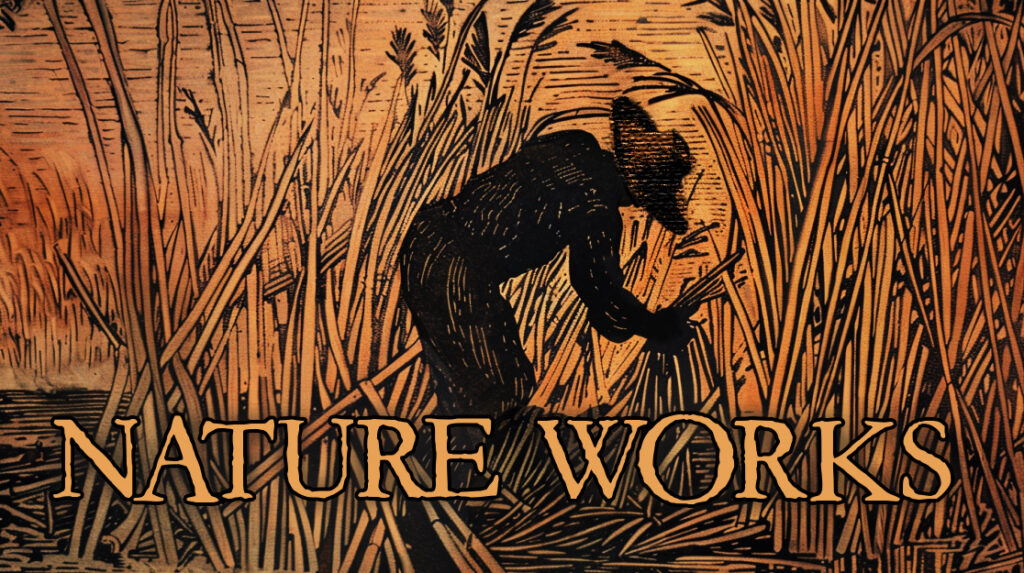Nature Works

This is a work in progress and currently includes the following planned pieces. Important guiding principles are that the process is equally important to the product, everything is made from personally harvested natural materials, and, as much as possible, everything would have been available before the Industrial Revolution. I am hoping to get an intimate understanding of the natural world, and my relation to it or place in it, by learning how to work and create with materials that I harvest with my own hands. Here is a brief outline of the different pieces I am working on.
- Dune Hike: This will be fulfilled as a journey on foot. I will hike for two to three days along the dune coast of Monterey Bay, California. The process of preparing for this is part of the piece. My gear will be handmade from harvested and processed natural materials as much as possible. A guiding principle in creating materials for this hike is that everything used would be available pre-1760, the beginning of the Industrial Revolution, using only materials that were available at that time and, if possible, making the majority of my gear myself. This will include a backpack held together with handmade cordage, water filter, blanket (wool), clothing of the material available pre-industrial age, shelter, stove, and any other items needed. I will, separately, carry modern tech to document the hike. Part of this piece is the creation and use of natural materials and part of the piece is the experience and the insights gained from doing this.
- Handmade cloth from harvested natural fibers.
- Luminaria: A multi-material lantern with a pinecone-laden bough, a wooden automata bird, and a full-moon background. Constructed of harvested wood, including eucalyptus and willow, weaving materials, natural handmade cloth, and handmade paper with embedded pine needles.
- Woven Basket: a multi-material classical basket; a pine basket; and an ivy foraging basket
- Sheaves: dry grass, bundles of tule, cattail, ivy, sticks, briar, and other materials bound with handmade cordage to hang on a wall, gate, or fence.
- Wild Clay: harvesting and processing wild clay, creating a piece, firing it in a small beach fire on the sand. Items envisioned: Clay medallions for baskets, beads, pookie, weighted disk for fire starter, a single pot, and probably a dorodanga, which is a clay ball in a traditional Japanese style.
- Walking Sticks: harvest several kinds of local wood pieces to make walking sticks with. They will be mounted on a harvested wood rack.
- Kite: this idea is a possibility but not yet certain. Although I think a kite can be made from natural fiber paper and thin harvested sticks, does the kite string need to be handmade from harvested fibers? I have to ponder that a bit more.
Finding a Connection with Nature
The work tends to show a connection to nature through old crafting techniques from natural materials. Showing and understanding the harvesting and processing of natural materials will be integral to the pieces. How it is created is as important as what is created.
Inspired by Pre-industrial Methods
The depicted ways of obtaining, processing, and manipulating natural materials into useful items are entirely based on common, ancient methods. Today, some of these methods fall under the special interest called “Bushcrafting”. Other influences are basket-weaving, lantern-making, cordage, and general foraging and harvesting of natural materials found in wild places. These wild places may or may not be found in urban areas. Harvesting in an urban area adds a layer to the meaning, and a teaching point, to this project.
The Primacy of the Methods
All of the work will be created from natural materials that are harvested and processed by hand. If it could have been achieved prior to 1760, the generally agreed beginning of the Industrial Revolution, then it passes the primary test. While some materials, such as beeswax, may come from animals, no animal parts will be used, except foraged bones or other naturally occurring artifacts found in nature. That is, this project is vegetarian but not necessarily vegan.
Time Frame for Completion
While I am currently working on this daily, I am setting no deadline at this point. I do imagine it will be finished this year, next year at the latest. Updates will follow as time goes on. In the meantime, I will attempt to post progress as I go.
Manner of Exhibition
While this exhibit would be best seen in person at a museum or gallery, I will assume this will not be a possibility. Therefore, everything will be documented with film, photography, sketches, and notes. I will organize it in a manner that can be viewed digitally online or in any other digital venue.

